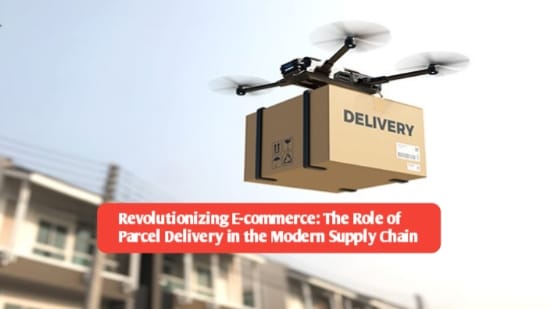Revolutionizing E-commerce: The Role of Parcel Delivery in the Modern Supply Chain, In today’s fast-paced digital world, parcel delivery has become a crucial component of the global supply chain. With the exponential rise of e-commerce platforms and consumer demand for fast, reliable shipping, the parcel industry has evolved to meet these needs by integrating cutting-edge technology and logistics solutions.
Parcel delivery typically refers to the transportation of small packages, often through courier services, for both business-to-consumer (B2C) and business-to-business (B2B) transactions. Companies such as UPS, FedEx, DHL, and regional carriers have expanded their services to include same-day and next-day delivery, catering to the “instant gratification” expectations of modern shoppers. Amazon, one of the largest e-commerce giants, has even introduced its own delivery network, leveraging autonomous technologies like drones and robotics to streamline operations.
Increased consumer expectations have prompted innovations in parcel tracking, allowing customers to monitor their shipments in real-time through sophisticated software systems. Furthermore, sustainable practices are being adopted by the industry to reduce the carbon footprint associated with last-mile delivery. Electric vehicles (EVs), bike couriers, and optimized delivery routes are among the steps being taken to promote eco-friendly shipping options.
Challenges, however, persist. Urban congestion, fluctuating fuel prices, and labor shortages continue to create obstacles in efficient parcel distribution. Nevertheless, the future of parcel delivery looks bright with advancements like AI-driven logistics, predictive delivery times, and even crowd-sourced delivery models contributing to faster and more reliable services.
The parcel industry will remain an integral part of the growing e-commerce economy, and as technology continues to advance, the speed, efficiency, and environmental impact of parcel delivery are expected to improve dramatically.
This article offers a comprehensive overview of parcel delivery’s significance in modern commerce and explores the evolving trends in logistics and technology shaping the industry.
Latest parcel innovations?
Recent innovations in parcel delivery are transforming the logistics landscape, focusing on speed, efficiency, sustainability, and customer satisfaction. In 2024, several key trends are shaping the industry:
- AI-Powered Real-Time Tracking: Companies are increasingly using AI and machine learning for predictive analytics, enabling real-time adjustments to delivery routes based on traffic, weather, and potential disruptions. This technology helps streamline operations and improve delivery accuracy(Dropoff).
- Automation in Last-Mile Delivery: Automated management platforms and route optimization software are helping businesses handle complex delivery logistics more efficiently. By integrating AI, businesses can reduce fuel consumption, minimize delivery times, and manage higher delivery volumes(Dropoff).
- Sustainability and Electric Vehicles: As environmental concerns grow, logistics companies are embracing sustainable solutions, such as electric vehicles (EVs) and sustainable aviation fuel (SAF). These innovations reduce the carbon footprint of deliveries and are particularly important for meeting the increasing consumer demand for eco-friendly options(DHL)(OneRail).
- Drone Deliveries and Local Carrier Partnerships: Companies like Walmart have begun experimenting with drone deliveries for faster, more localized service. Additionally, partnering with local delivery services offers greater flexibility and efficiency, particularly in last-mile logistics(Dropoff)(OneRail).
These innovations, driven by AI, automation, sustainability, and local logistics partnerships, are shaping the future of parcel delivery by making it faster, more reliable, and eco-friendly.
Best drone services?
The best drone delivery services have been rapidly evolving, with several key players leading the innovation in this field:
- Amazon Prime Air: One of the most well-known drone delivery initiatives, Amazon Prime Air aims to deliver packages weighing up to 5 pounds in 30 minutes or less. After years of development, the service received FAA approval and began trial services in select areas. The program is still expanding and refining its capabilities(OneRail).
- Zipline: Known for its medical supply deliveries, Zipline uses fixed-wing drones to deliver blood, vaccines, and other critical supplies in rural and hard-to-reach areas. Their success in Africa, especially in countries like Rwanda and Ghana, has prompted expansion into the U.S. for healthcare-related deliveries(Dropoff).
- Wing (by Alphabet): Wing, owned by Google’s parent company Alphabet, offers drone deliveries in the U.S., Finland, and Australia. Its drones can carry packages of up to 3 pounds and have been praised for their advanced flight systems, precision, and speed. Wing has been successfully integrating with local businesses to provide consumer goods and food deliveries(DHL)(Dropoff).
- UPS Flight Forward: UPS’s drone subsidiary focuses on healthcare and other essential deliveries. It became the first drone service to receive FAA approval for full-scale commercial operations in the U.S. They have partnerships with healthcare facilities to transport lab samples and medical supplies(OneRail).
These services are revolutionizing last-mile logistics, particularly in time-sensitive deliveries like healthcare, and their scope is gradually expanding into general consumer deliveries as technology and regulations evolve.
Cost of drone deliveries?
The cost of drone deliveries can vary significantly depending on the provider, region, package weight, and operational factors. As drone delivery is still in the early stages of commercialization, here are some insights into current pricing structures:
- Amazon Prime Air: While still in limited trials, Amazon’s drone delivery service has not yet finalized public pricing. However, considering Amazon’s emphasis on fast, low-cost delivery, it’s expected that drone delivery for lightweight packages (under 5 pounds) would be included for Amazon Prime members or incur a small additional fee for rapid service(OneRail).
- Zipline: In rural areas of Africa, where Zipline focuses on delivering medical supplies, the cost of deliveries is highly subsidized, often covered by governments or NGOs. In more commercial applications, Zipline’s delivery costs range from $5 to $25 per delivery depending on distance and urgency. Expansion into consumer deliveries could adjust this pricing(Dropoff).
- Wing (Alphabet): Wing operates in certain U.S., Australian, and European markets, and its costs are competitive with traditional delivery services. In trials, customers have been charged between $3 and $6 for small parcels, similar to regular shipping fees for same-day services(DHL).
- UPS Flight Forward: Targeting the healthcare sector, UPS focuses on medical deliveries, such as lab samples or prescriptions. Due to its highly specialized nature, these deliveries may cost more than typical consumer packages, though prices vary by contract. UPS offers subscription models for healthcare facilities, covering drone deliveries in bulk(OneRail).
As the technology matures and regulations are streamlined, costs are expected to decrease, potentially making drone deliveries a cost-effective alternative to traditional delivery methods.
How did you like the information given in our article today, please tell us in the comment section and for more such posts, follow our page The News House, thank you
Reed more… DESHAUN WATSON: A TUMULTUOUS JOURNEY FROM NFL STARDOM TO CONTROVERSY


